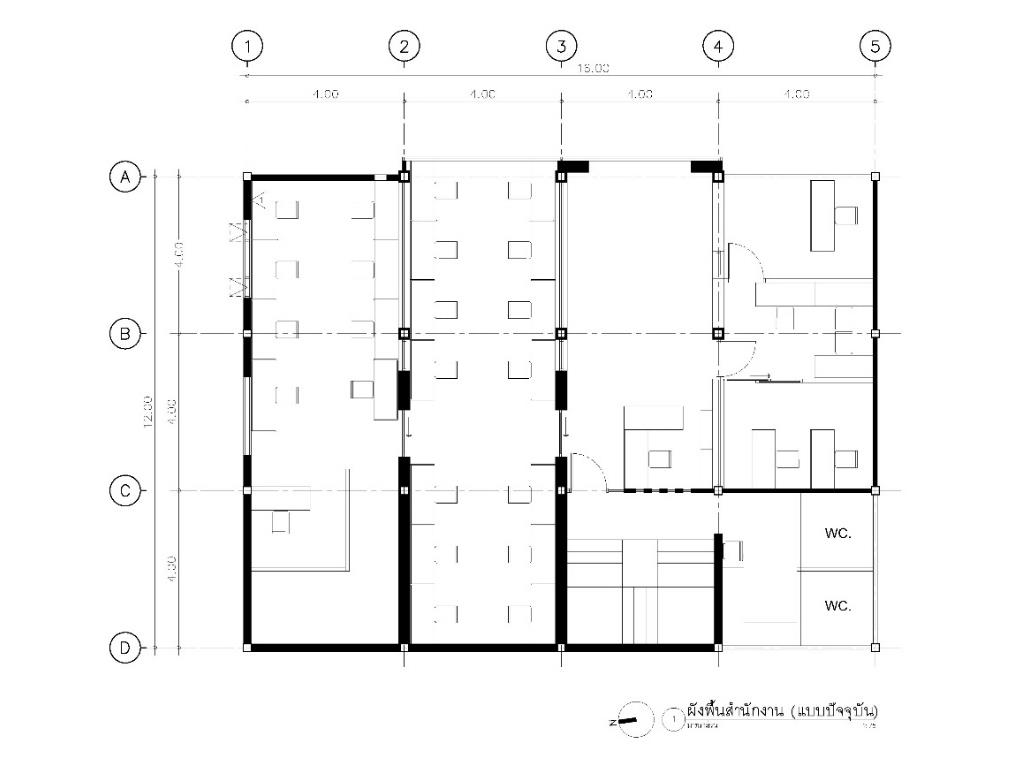Indoor Air Quality Improvement in Office: Case Study of Interior Renovation for Office Use
Main Article Content
Abstract
Indoor air quality in an office has a direct impact to people who are working in the office space. The objective of this research is to study how to improve indoor air quality in a case study of interior renovation for office usage from small in commercial buildings which has the, amount of carbon dioxide exceeds the standard level. Carbon dioxide level during 07:00 – 19:00 hrs. in selected office were collected. Alternative ways of solving high CO2 problem by introducing fresh air from outside the building were tested and measured. Both methods of bringing outdoor fresh air into the space through openings passively and actively were explored. Outdoor ventilation using active method drawn fresh air by the volume that complied with ASHRAE 62.1 standard.
It has been found that supplying fresh air into office spaces passively could not reduce the CO2 level below the standard. Using ventilation fan to supply outdoor air into the space could reduce amount of carbon dioxide below the standard level at 1000 ppm. However, air filters should also be used to control the amount of PM 2.5 dust and PM 10 dust to the standard level.
Article Details

This work is licensed under a Creative Commons Attribution-NonCommercial-NoDerivatives 4.0 International License.
References
ANSI/ASHRAEStandard62.1-2019. (2019). Ventilation for Acceptable Indoor Air Quality. American Society of Heating. Retrieved from ashrae.iwrapper.com
ANSI/ASHRAEStandard. (2016). HVAC Systems and Equipment. 2016 ASHRAE Handbook. Retrieved from http://www.ashrae.org
Janis J. (2011). Theories and Knowlage About Sick Building Syndrome. Springer-Verlag Berlin Heidelberg, 25-58.
Rich Prill. (2002). Why Measure Carbondioxide in Building? [Online]. Washington State University Extension Energy Program. Retrieved from http://energy.wsu.edu/documents/co2inbuildings.pdf
WorldHealthOrganization. (2010). WHO Guidelines for Indoor Air Quality [Online]. Retrieved from http://euro.who.int/__data/assets/pdf_file/0009/128169/e94535.pdf
นภดนัย อาชวาคม. (2554). คุณภาพอากาศภายในอาคาร [ออนไลน์]. Retrieved from http://lib3.dss.go.th/fulltext/dss_knowledge/phy_5_2559_indoor_air_quality.pdf
นีรวรรณ จันทวงศ์. (2553). ความหมายความสำคัญของงานสำนักงาน [ออนไลน์]. Retrieved from http://www.l3nr.org/posts/383930
ป๋วยอึ๊งภากรณ์เวิร์ดเพลส. (2558). การระบายอากาศ [ออนไลน์]. Retrieved from http://pueyunphakorn.files.wordpress.com
ลภดล โมกขะสมิต. (2553). การจัดการคุณภาพอากาศภายในอาคาร [ออนไลน์]. Retrieved from http://www.arch.ku.ac.th/2010/attachments/sheet/IAQ.pdf
วันทนี พันธุ์ประสิทธิ์ (2543). คู่มือปฏิบัติการมลพิษภายในอาคาร. กองอนามัยและสิ่งแวดล้อม สำนักอนามัย.
สถาบันอาคารเขียวไทย. (2556). เกณฑ์การประเมินความยั่งยืนทางพลังงานและสิ่งแวดล้อมไทยสำหรับอาคารระหว่างใช้งาน [ออนไลน์]. Retrieved from http://tgbi.or.th/uploads/trees/เกณฑ์%20TREES-EB_160921.pdf
สร้อยสุดา เกสรทอง. (2549). SBS Sick Building Syndrome โรคจากการทำงานในตึก. สำนักโรคจากการประกอบอาชีพ และสิ่งแวดล้อม กรมควบคุมโรค กระทรวงสาธารณะสุข.
สำนักควบคุมและตรวจสอบอาคาร กรมโยธาธิการและผังเมือง. (2552). กฎกระทรวงฉบับที่ 55 พ.ศ. 2543. คู่มือกฎหมาย ควบคุมอาคาร.
สำนักอนามัยสิ่งแวดล้อม กรมอนามัย กระทรวงสาธารณะสุข. (2559). คู่มือปฏิบัติงานเพื่อการตรวจประเมินคุณภาพ อากาศภายในอาคาร. กรมอนามัย กระทรวงสาธารณะสุข.
สุพจน์ เตชะอำนวยวิทย์. (2551). การตรวจวัดคุณภาพอากาศภายในอาคาร. บทความวิชาการสมาคม วิศวกรรมปรับ อากาศแห่งประเทศไทย, 14.


